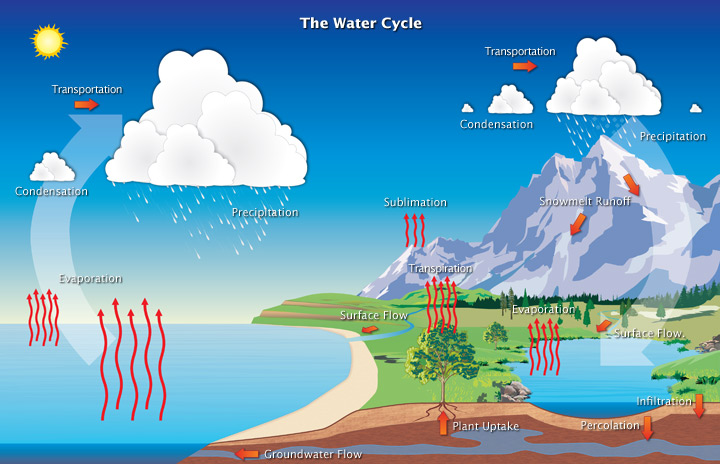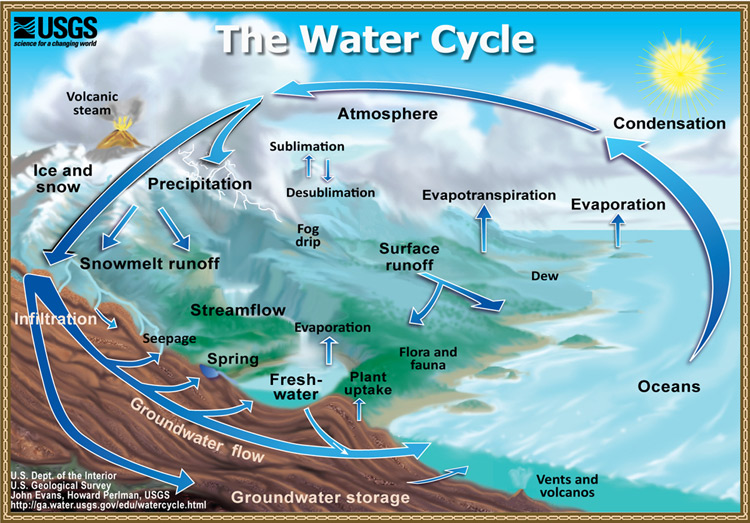What Is the Second Step in the Water Cycle
The three major water cycle steps are evaporation condensation and precipitation. Water in the Oceans.

The Water Cycle For Kids How It Works Diagram Facts Water Cycle Water Cycle For Kids Water Cycle Unit
This helps track how the ocean.

. Stages of Water Cycle. However we are going to go through every step of the water cycle just so we do not miss anything. This runoff combines to form channels rivers and ends up into lakes seas and oceans.
The cycle has four stages as mentioned above. Together all of the steps help regulate the Earths water supply and climate. When this happens some of the water evaporates into the air turning into a gas called vapour.
The process by which water from its liquid state changes to vapour a gaseous state is termed as evaporation. The complete water cycle is carried into four stages which are as follows. Sublimation occurs when the snowice does not melt skipping the liquid phase and instead coverts back to a gas.
Sublimation is when precipitation returns to the earth as snow or ice. Plants and trees also lose water to the atmosphere through their leaves. CONDENSATION- PROCESS BY WHICH WATER VAPOR CHANGES BACK INTO A LIQUID THE SECOND STEP OF THE WATER CYCLE.
As Earths climate becomes warmer land ice at the North and South Poles starts melting. As water runs over the ground it displaces the top soil with it and moves the minerals along with the stream. This cycle consists of three major steps along with a few additional steps.
Water covers roughly 70 percent of the Earths surface and is one of the basic elements of nature. Water vapour condenses into. Runoff is the process where water runs over the surface of earth.
Evaporation condensation precipitation and transpiration. The stages being evaporation condensation precipitation and collection. PRECIPITATION THE PROCESS BY WHICH WATER RETURNS TO THE EARTH IN THE FORM OF RAIN SNOW SLEET AND HAIL THE THIRD STEP OF THE WATER CYCLE.
Water Cycle Overview Article. All living systems in the _____ depend on earths other systems to survive. It is the amount of water that reaches the streams and rivers.
Made in partnership with the National Science Teaching Association. Evaporation Condensation Precipitation and Collection. When the snow melts into water it also leads to runoff.
Make a larger version of the water-cycle model using a large clear plastic container. Water vapor surrounds us as an important part of the air we breathe. The water cycle also known as the hydrologic cycle consists of four distinct stages.
Evaporation is the process of a liquids surface changing to a gas. In the water cycle liquid water in the ocean lakes or rivers evaporates and becomes water vapor. Then set up a second large version of the water cycle in which a small section of the lid has been cut away.
Measure the depth of the water before sealing. The water cycle is the continuous motion of water above and below the Earths surface. Precipitation This is where the clouds became heavy.
Liquid water evaporates into water vapor condenses to form clouds and precipitates back to earth in the form of rain and snow. What is the second step of the water cycle. The significant processes in the water cycle are evaporation transpiration condensation precipitation and runoff.
The water falling on land collects in rivers and lakes soil and porous layers of rock and much of it flows back into the oceans where it will once more evaporate. PRECIPITATION THE PROCESS BY WHICH WATER RETURNS TO THE EARTH IN THE FORM OF RAIN SNOW SLEET AND HAIL THE THIRD STEP OF THE WATER CYCLE. The water vapour rises into the air.
The next stage of the water cycle is sublimation. Liquid water flows across land runoff into the ground infiltration and percolation and through the ground groundwater. NASAs Jason-3 missionshort for Joint Altimetry Satellite Oceanography Network-3orbits Earth collecting information about sea level and ocean temperature.
Because it is a cylce there is no definite beginning or end point to the cycle. What is the second step of the water cycle. The water then flows into the ocean causing sea level to rise.
This is the initial stage of the water cycle. Make sure that the water in the second model is exactly the same. Energy from the sun heats up the surface of the Earth causing the temperature of the water in our rivers lakes and oceans to rise.
Evaporation a process where water disappears because of heat and becomes water vapor. Runoff refers to the water discharged after infiltration and percolation. The cycling of water in and out of the atmosphere is a significant aspect of the weather patterns on Earth.
When there is more water than the land can absorb runoff occurs. A container from a salad bar works well. In order the steps of the water cycle are evaporation condensation sublimation precipitation transpiration runoff and infiltration.
Up to 24 cash back This is the main way in which water cycle returns its to the earth. Water in different phases moves through the atmosphere transportation. In a negative feedback loop if one variable _____ the second variable increases.
Ad Includes lesson plans worksheets quizzes DIY activities you can do in the classroom. The water cycle consists of three major processes. In which step of the water cycle does the water return to land and falls from the clouds.
Condensation is when water vapor is collected and mixed together with dust thus forming a cloud. CONDENSATION- PROCESS BY WHICH WATER VAPOR CHANGES BACK INTO A LIQUID THE SECOND STEP OF THE WATER CYCLE. Water evaporates into the air.
The sun heats up water on land in rivers lakes and seas and turns it into water vapour. Evaporation condensation and precipitation.

The Water Cycle Article Ecology Khan Academy


No comments for "What Is the Second Step in the Water Cycle"
Post a Comment